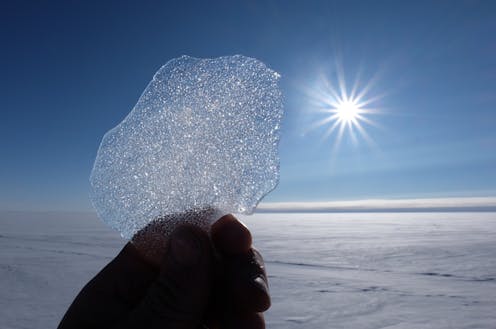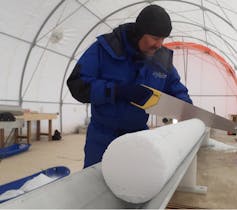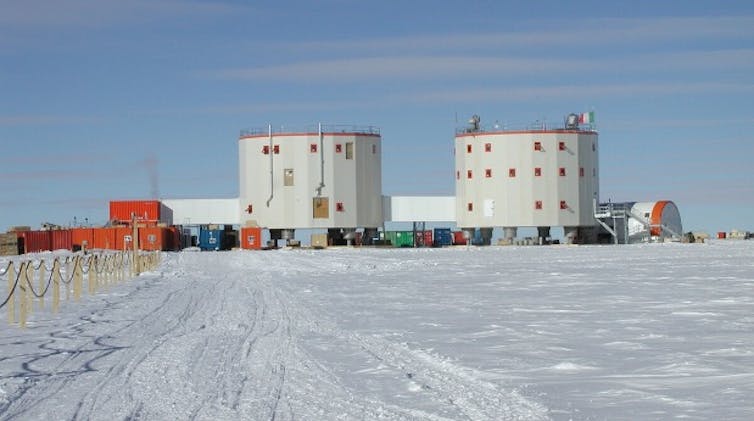
The atmosphere is constantly changing. Its composition has varied regularly over the course of the planet’s climatic epochs, particularly with regard to its levels of carbon dioxide (CO2) concentration, a crucial factor in determining Earth’s climate.
Analysis of air bubbles trapped in ice cores has made it possible to reconstruct these variations in composition over the last 500,000 years. This is shown by our study published in the journal Nature Geoscience, which shows recent “jumps” in CO2 that correspond to increases of around 10 parts per million (ppm) in less than a century in atmospheric CO2 concentrations.

These “jumps”, which correspond to the most abrupt natural variations in atmospheric CO2 that have occurred in the climate’s past, remain much smaller in amplitude than the recent increase that is at the root of global warming.
The study shows that these jumps in CO2 occurred at times when the inclination of the Earth’s axis of rotation in relation to the plane of its orbit around the Sun, known as obliquity, was high. The Earth is currently in a period of high obliquity.
And that’s not all: these jumps are triggered by disturbances in the Atlantic Meridional Oceanic Circulation (AMOC), a major ocean current in the North Atlantic that plays a crucial role in regulating the climate and which is currently showing signs of slowing down.
This could lead to an additional CO2 jump on top of human-made emissions.
CO₂ “jumps”: what exactly are we talking about?
These jumps in atmospheric CO2 correspond to increases of around 10 parts per million (ppm), in the space of a century, in atmospheric concentrations over the last half-million years.
Although significant, these increases remain, on average, 10 to 20 times smaller than the increase in human-made emissions. Over the last approximately 100 years, the increase is estimated at 115 ppm, 10 times greater than the observed jumps in CO2.

The analysis of this ice core, a long tube of ice around 10 centimetres in diameter taken from several kilometres deep in Antarctica, whose surface is almost entirely covered in ice, was carried out at the Grenoble Institute of Environmental Geosciences.
It identified seven new CO2 jumps during the period from 260,000 to 190,000 BC and 15 jumps already recorded in previous records.
Above all, it has shown that 18 of the 22 CO2 jumps studied occurred when the planet’s obliquity was high.
A coincidence of two phenomena
The CO2 jumps, which are abrupt phenomena, are in fact caused by the contingency of two phenomena.
The initial trigger for these jumps is the disruption of the AMOC, a major player in the regulation of the Earth’s climate. The cessation of the AMOC leads to a shake-up of precipitation and temperature on a global scale.
However, this necessary condition is not sufficient: every disruption to the AMOC does not systematically lead to a jump in CO2. This is where the second key parameter in the occurrence of CO2 jumps comes into play: the obliquity of the Earth, which corresponds to the Earth’s tilt in relation to the Sun as it rotates around it.
This obliquity is not constant: it varies regularly between around 22° and 25°, through cycles of 41,000 years.
This variation influences the distribution of the Sun’s energy at the Earth’s surface, which has a direct impact on regional climates and the geographical distribution of terrestrial environments, including the types of vegetation that store carbon. Our results suggest that these changes in the terrestrial distribution of vegetation, particularly in the Middle East and sub-Saharan Africa, lead to the build-up of large stocks of CO2 in biomass, which can then be destocked during AMOC perturbation, causing CO2 jumps.
CO₂ jumps and climate change: a double whammy?
The Earth is currently in one of these periods of high obliquity. In the event of a major disruption to Atlantic Ocean circulation, in particular a slowdown in the AMOC, a quantity of carbon equivalent to four years of global anthropogenic emissions (at the rate of average emissions over the period 2010-2019) could thus be released in the space of a few decades, thus adding to current anthropogenic emissions.

At present, there are still major uncertainties in the modelling associated with the AMOC, some of it suggesting that the oceanic circulation is slowing down as a result of climate change caused by human activities. In the event of a collapse of the AMOC, a new jump in CO2 could occur, leading to new CO2 emissions from natural sources destabilised by human activity, which would amplify climate change.

Created in 2007 to accelerate and share scientific knowledge on major societal issues, the Axa Research Fund has supported nearly 700 projects worldwide, led by researchers from 38 countries. To find out more, visit the Axa Research Fund website or follow us on X @AXAResearchFund.
Etienne Legrain has received funding from Make Our Planet Great Again through the HOTCLIM project of the Agence Nationale de la Recherche and the ‘Programme d'Investissements d'Avenir’ (ANR-19-MPGA-0001).
Emilie Capron has received funding from the Make Our Planet Gret Again initiative through the HOTCLIM project managed by the Agence Nationale de la Recherche under the ‘Programme d'Investissements d'Avenir’ (ANR-19-MPGA-0001).
This article was originally published on The Conversation. Read the original article.







